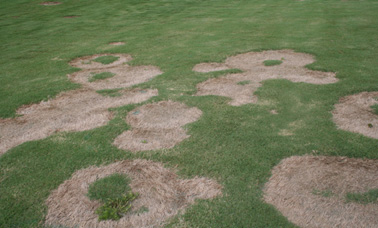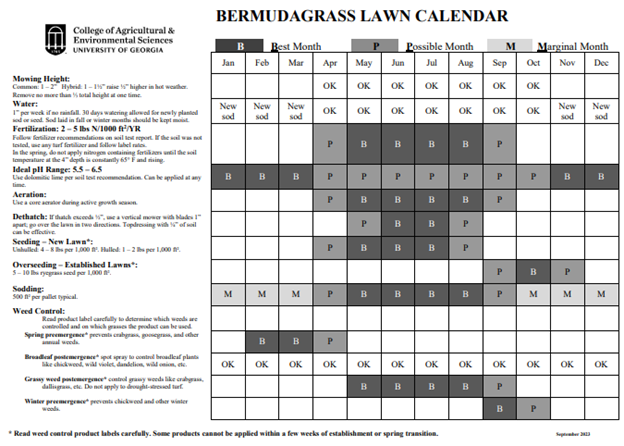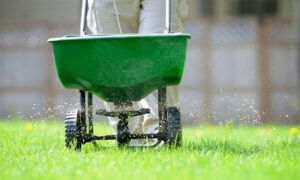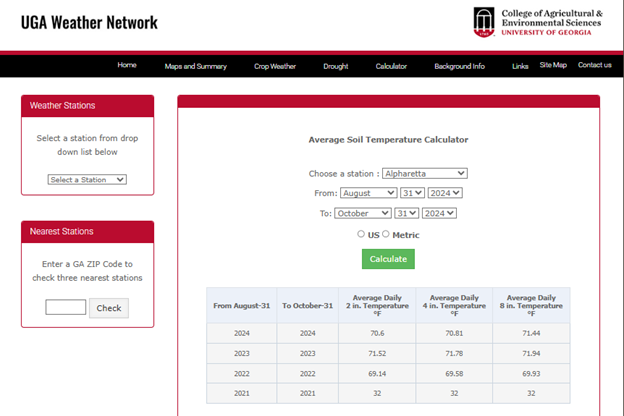
Heather N. Kolich, ANR Agent, UGA Extension Forsyth County
School is back in session and autumn is only a few weeks away. If you have a warm-season lawn, now is the time to get it ready for winter. Proper care in late summer and early fall helps bermuda grass, centipede grass, and zoysia grass lawns enter dormancy at the appropriate time, protects against cold injury, prevents winter weeds, and reduces disease problems during spring green-up.

Stop applying nitrogen. Nitrogen stimulates growth, something that we want during the active growing season. At the end of August, however, active growth stops for warm-season grasses as they prepare to enter dormancy to survive the winter season. Fertilizing in September can delay dormancy and expose warm-season turf grasses to injury from frosts and freezing weather. Applying nitrogen in the fall also sets lawns up for Spring Dead Spot (see more below). It’s ok to make a final application of nitrogen in August to very early September, but as days get shorter and nights grow cooler, let warm-season turf grasses go through the natural cycles to enter dormancy.
Adjust mowing height. The normal mowing height range for bermuda grass, centipede grass, and zoysia grass is 1-2 inches. If you’ve been mowing on the lower side, raise the mower blade up to cut at the 2-inch height. Longer grass improves soil moisture retention and denies sunlight to annual winter weed seedlings.
Continue irrigation. Warm-season lawns still need an inch of water per week as they slow growth for dormancy. Watering deeply and less frequently encourages roots to grow deeper into the soil. If rainfall is sufficient, skip irrigation; over-watering encourages root rot and other turf grass diseases.
Collect a soil sample for testing. Fall is an excellent time to apply lime – if it’s needed. Each species of warm-season turf grass has a different optimal pH range. If soil pH is too low, dolomitic lime can be applied to raise it, but it’s a process that can take several months. If soil pH is too high, applying lime can cause plant stress and poor growth.

Apply pre-emergence herbicide. If you’ve had lawn weeds in the past, you probably have weed seeds in the soil that will start sprouting as soon as the soil temperature and moisture conditions are right for growth. A pre-emergence herbicide interrupts seed germination so that weeds don’t get a chance to grow into seedlings. The product must be applied before the environmental conditions are right for seed germination to begin, and most need to be watered-in after application to move into the soil.
For winter annual weed control, apply pre-emergence herbicides in late August to mid-September, before nighttime air temperatures consistently dip below 60° F, or before soil temperatures cool to 55° F, the point at which winter weed seeds can begin to germinate. These herbicides contain various active ingredients and typically control several broad-leaf annual weeds and some annual grass weeds. The products continue working in the soil for several weeks. Some products allow or recommend a second application 8-10 weeks after the initial treatment.
A pre-emergence herbicide that contains potassium as the carrier product will enhance winter hardiness in bermuda grass lawns. Look for pre-emergence herbicides that have 0-0-7 or something similar, with the first two numbers (for nitrogen and phosphorous) being zeros. Note that products containing atrazine should not be used on bermuda grass lawns.
Apply a fungicide for Spring Dead Spot control. The fungi that cause spring dead spot actively feed on turf grass roots during the cooler, wetter weather of fall and spring. They become active when soil temperature drops below 70° F, and they continue to feed until they go dormant when soil temperature drops below 50° F. Their root feeding weakens turf grasses and makes them more susceptible to winter kill.

Fall management of spring dead spot is most effective when the fungicide is applied at soil temperatures between 75° and 60° F, typically in late August through mid-September. The fungicide should be watered-in immediately after application to reach the turf grass root zone. If spring dead spot was diagnosed at spring green-up, a second fungicide application, at the label specified interval, is recommended.
Lawn Care Resources
UGA Extension has many resources for lawn and landscape management.
- To check soil temperature and many other weather trends, visit the UGA Georgia Weather Net at www.georgiaweather.net.
- For lawn care calendars and information on soil testing, please visit the Forsyth County Extension website at https://turf.caes.uga.edu/publications/Lawn_Care_Calendars.html.
- For pesticide information and selection, refer to the Georgia Pest Management Handbook at https://ipm.uga.edu/georgia-pest-management-handbook/. Scroll to the bottom of the page for the Homeowner Edition.